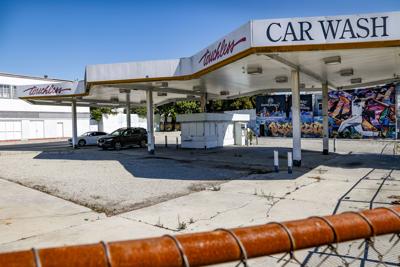- By Keith Menconi | Examiner staff writer
- Sep 25, 2025 (SFExaminer.com)

A long-stalled project to redevelop a vacant gas station bordering the Haight Ashbury and Hayes Valley neighborhoods has helped inspire the latest effort to reform San Francisco’s permitting process.
For years, The City’s housing boosters have held up the unsightly property at 400 Divisadero St. — a choice piece of real estate near the Panhandle and several public-transit lines — as a prime example of San Francisco’s inability to get homes built.
The project even became a flashpoint in last November’s District 5 supervisorial race when a political-advocacy group supporting challenger Bilal Mahmood paid for a billboard overlooking the gas station that read “That car wash should be affordable homes. Bilal Mahmood will fix it.”
Now, Mahmood — who defeated former Supervisor Dean Preston in that election — has introduced legislation that he says will help fix bureaucratic road blocks holding back 400 Divisadero and many other projects in The City that have been mired in lengthy delays due to a lack of financing.
With high construction and borrowing costs putting a serious squeeze on San Francisco developers, projects have slowed to a snail’s pace in recent years. In response, Mahmood said, his office has been meeting with builders to try to answer a burning question.
“How do we actually eliminate the red tape that is kicking these projects while they’re down and ensuring that we continue to make more momentum?” he said.
What Mahmood has hit upon is a proposal announced earlier this month that he said attempts to reform permitting requirements that only compound delays, contributing to what he terms a “housing death spiral.”
As things stand now, The City requires builders to use construction plans that adhere to the current building code, which sets standards for buildings’ plumbing, electrical utilities, physical structures and more.
But given that San Francisco updates its building code every three years, that requirement can mean that as code changes pour in, stalled projects — some of them held up for years on end — might need to make costly revisions to their original proposals.

EX // TOP STORIES
Fillmore investment plan announced after cuts to similar effort in Tenderloin
Mayor Daniel Lurie and Supervisor Bilal Mahmood announced the new process just months after an ongoing plan in the Tenderloin was shorted $4 million in the city budget
How historic Tenderloin SRO became early supportive housing pioneer
The Cadillac Hotel was epicenter of a movement intent on securing affordable housing by preserving The City’s old residential buildings
SF poised to expand list of historic landmarks amid fears of redevelopment
Preservationists warn that if city leaders succeed in their plans to spur new housing growth, many historic buildings could soon face demolition
Mahmood’s legislation would allow projects to move forward in accordance with the building code that was in place at the time of their original applications. The change would bring San Francisco in line with standards set by the state, Mahmood said.
A separate measure in the legislative package — which is expected to go before the Board of Supervisors in October — would also loosen rules that currently require projects that have already won permits but have not yet finished construction to reapply each year.
“That will save the project time and also save staff time inside City Hall as well,” Mahmood said.
A little more than 71,000 homes are working their way through San Francisco’s housing pipeline, according to a data portal maintained by the Planning Department. Of those, more than 80% (57,000) have earned initial approvals but have not yet made it through The City’s full process of design and review for construction plans.
In its current form, the redevelopment plan for 400 Divisadero calls for the construction of an eight-story apartment building that would include 203 new units of housing. While the project has been in the works for about 10 years, a combination of financial setbacks and political wrangling over the plan have prevented it from moving past the early stages of development.
Amir Massih, who leads 4Terra Investments, the development company behind the project, said that if passed, Mahmood’s proposal would allow construction to proceed under a 2016 version of The City’s building code. In turn, he said, that would reduce the construction costs by as much as 7%, or about $5 million.
While 4Terra Investments is still working to complete pre-construction planning for the 400 Divisadero project, Massih said such a financial boost would significantly improve the chances that the proposed apartment complex would eventually get built.
“The closer you can get your project to the point where you’ve removed all of the brain damage that you’ve got to go through to get your project to be construction-ready, the better shot you have of being able to get financing and get investment,” Massih said.
Correction: This article has been updated to clarify the status of San Francisco’s building projects that have earned initial approvals but not yet begun construction.





